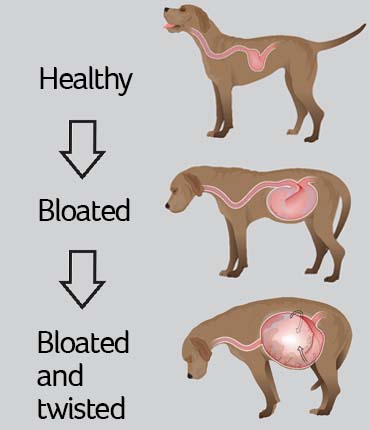GDV (Gastric Dilatation Volvulus) in dogs
GDV (Gastric Dilatation Volvulus) in dogs
Overview
- GDV (a bloated, twisted stomach), is a painful, life-threatening condition that requires emergency treatment.
- Bloat and retching are the most common symptoms of a GDV.
- Contact your vet immediately if your dog has symptoms of a GDV. Never wait to see if things improve - faster treatment means a better chance of survival.
- If your dog has a GDV, they will need an operation to un-twist their stomach but sadly, due to the seriousness of the condition, even with treatment, some GDVs are still fatal.
- Deep chested, large and giant breed dogs are most at risk of a GDV.
What is GDV?
A GDV is when the stomach bloats and twists around itself. Once the stomach twists, it quickly starts to fill with gas, causing severe and life threatening bloat. The only cure for a GDV is an operation to reverse the twist but sadly, due to the seriousness of the condition, even with treatment, some GDVs are still fatal.
Symptoms of GDV
- Bloat (a swollen tummy)
- Retching (trying to vomit without bringing anything up)
- Vomiting
- Excessive drooling
- Stomach pain
- Pale gums
- Collapse.
Symptoms of a GDV tend to start very suddenly, and get worse quickly. Dogs are at more risk after they have eaten or drunk a lot, especially if they exercise straight afterwards.
Treatment
If your vet suspects a GDV, treatment is likely to involve:
- X-rays/scans - to confirm the twisted stomach.
- A fluid drip - dogs with a GDV tend to go into shock and develop dangerously low blood pressure, a fluid drip helps to keep blood pressure up.
- Attempts to reduce bloat - your vet may need to release some of the gas from your dog’s stomach before their operation.
- Surgery - your dog will need an operation to untwist their stomach and check it for damage. After untwisting it, your vet may decide to stitch your dog’s stomach into place to reduce the chance of it happening again. Your vet will also check your dog’s spleen because it sits very close to the stomach and can get caught in the twist. The spleen may need to be removed if it’s been badly damaged.
- Pain relief - a GDV is an extremely painful condition so pain relief will be given to make your dog more comfortable.
Sadly, in some cases, especially if your dog is very unwell, has other illnesses, or is unlikely to survive the surgery, your vet may discuss putting them to sleep.

GDV is when the stomach bloats (fills with gas) and twists, trapping the gas. Click to enlarge.
After surgery
Recovery - after surgery, your dog may need to stay at your vets to be monitored for complications such as peritonitis (an infection inside the abdomen). They will be able to return home once your vet is happy that they are recovering well.
Home care - once your dog is home, you’ll need to continue monitoring them and look out for symptoms such as:
- A reduced appetite
- Low energy
- Vomiting
- Another episode of bloat.
Contact your vet immediately if you’re worried or notice any of the symptoms above.
Outlook
A GDV is a very serious condition, the sooner your dog is treated, the better their chance of survival; but sadly, due to the seriousness of the condition, some dogs die despite treatment. There are also high risks during the surgery, and potential for complications afterwards.
If your dog survives a GDV, there is still a risk that it could happen again - knowing the signs and acting fast is really important.
Causes and prevention of GDV
No one really knows why GDVs develop, but there are some factors that are known to make it more likely:
- Breed - large, deep chested dogs such as Great Danes, German Shepherds and Greyhounds are most at risk of GDV.
- Exercise around meal times - vigorous exercise or travelling in a car after a meal can increase the risk of a GDV.
- Eating quickly - eating quickly and gulping air can increase the chance of a GDV. Feed several small meals through the day rather than one big one and feed a mixture of wet and dry food. If your dog gulps his/her food, consider using a slow feeding bowl or scatter feeding.
- Feeding from a height - feed from the floor, not from a raised bowl. Previous advice was to feed from a raised bowl, but this has now been shown to increase the risk of a GDV.
- Gulping water - drinking a lot of water in one go can increase the chance of a GDV, try to encourage your dog to drink little and often (but never withhold water).
- Excitable/nervous dogs - excitable and nervous dogs tend to be more prone to developing a GDV.
Comments
Post a Comment